SATURN V APOLLO FACT SHEET
By Cliff Lethbridge
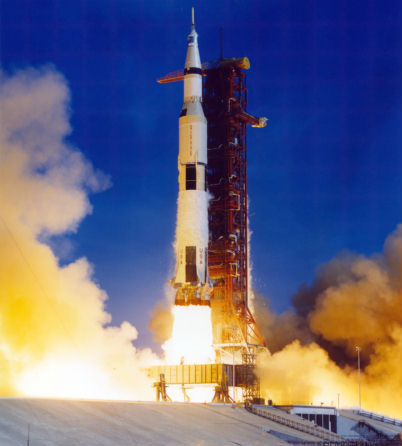
Saturn V Apollo Launch, Photo Courtesy NASA
Classification: Space Launch Vehicle
Length: 363 feet, 8 inches
Diameter: 33 feet
Finspan: 63 feet
Date of First Cape Canaveral Launch: November 9, 1967
Date of Final Cape Canaveral Launch: December 7, 1972
Number of Cape Canaveral Launches: 12
The world’s largest and most powerful space launch vehicle, the Apollo Saturn V was designed and built for the specific purpose of sending men to the Moon. Design and construction work was initiated under the Saturn C-5 designation in January, 1962. As was the case with the Saturn C-I and Saturn C-IB, the “C” designation was removed in February, 1963. Although the Saturn V employed some technology which dated back the earliest days of the U.S. space program, the sheer magnitude of the rocket and its mission successfully demonstrated one of the greatest scientific achievements in human history. One of the legacies of the Saturn V program remains the Kennedy Space Center, which was built on Merritt Island because not enough land was available on Cape Canaveral to support such a large vehicle. Construction of the most distinctive feature of the Kennedy Space Center, the cavernous Vehicle Assembly Building (VAB), was required to provide a secure indoor facility in which to stack the huge Saturn V components.
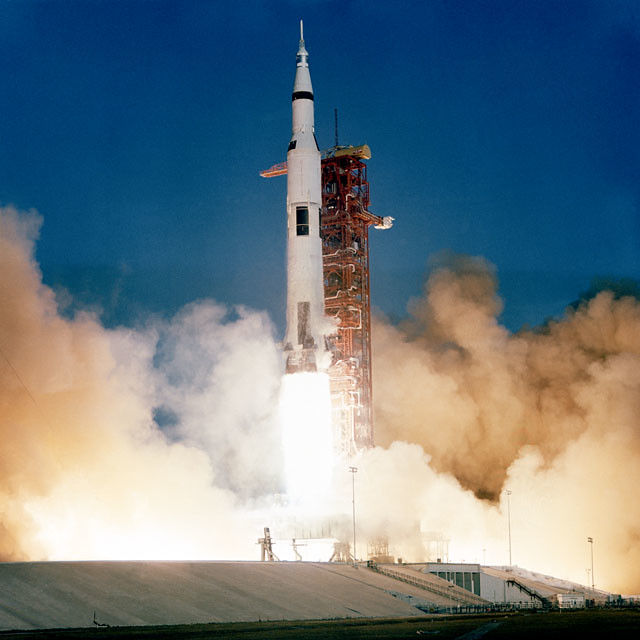
Saturn V Apollo Launch, Photo Courtesy NASA
Launch Pads 39A and 39B were built, along with numerous Saturn V launch support facilities. The tall Saturn V service gantries were built just outside the VAB. These were rolled into the VAB atop the Saturn V crawler/transporter, which was adapted from existing Earth-moving machinery. Inside the VAB, the stacked Saturn V was attached to the service structure and both were transported to the launch pad atop the crawler/transporter. A full test of virgin launch facilities at the Kennedy Space Center was performed on May 25, 1966 using a full-size Saturn V mock-up. The first test launch of a Saturn V occurred from Launch Pad 39A on November 9, 1967. This flight was designated Apollo 4.
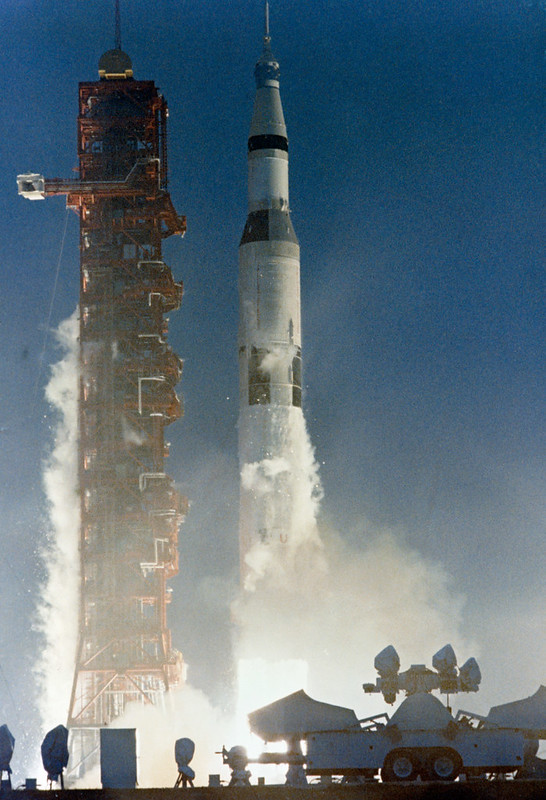
Saturn V Apollo Launch, Photo Courtesy NASA
A complicated three-stage rocket, the Saturn V employed a total of 41 separate motors to carry the Apollo Command Service Module/Lunar Module (CSM/LM) combination into Earth orbit and lunar trajectory. The S-IC first stage was built by Boeing and measured 138 feet tall by 33 feet wide with a 63-foot finspan. The powerful first stage employed five Rocketdyne F-1 engines which burned liquid oxygen/RP-1 (kerosene) liquid fuel and produced a combined 7,500,000 pounds of thrust at liftoff. The S-II second stage was built by North American and measured 81 feet, 6 inches tall by 33 feet wide. It employed five Rocketdyne J-2 engines which burned liquid oxygen/liquid hydrogen and could produce a combined thrust of 1,000,000 pounds.
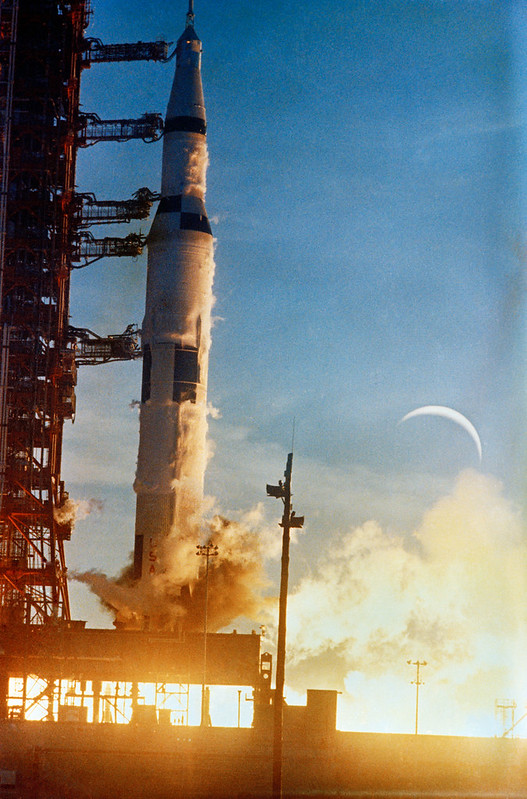
Saturn V Apollo Launch, Photo Courtesy NASA
The S-IVB third stage, also used as a second stage on the Saturn IB, was manufactured by Douglas Aircraft. It measured 58 feet, 8 inches tall by 21 feet, 8 inches wide. The S-IVB employed one Rocketdyne J-2 engine which could produce a thrust of 200,000 pounds. A NASA-designed and built Instrument Unit (IU) attached to the top of the S-IVB by special adapter measured 3 feet tall by 21 feet, 8 inches wide. The IU housed equipment which controlled all electronic commands for Saturn V control and guidance during ascent. In a typical Saturn V Apollo flight profile, the five F-1 first stage engines were ignited six seconds before liftoff. The center F-1 engine was shut down 135 seconds after launch. The outer four F-1 engines were shut down 15 seconds later.
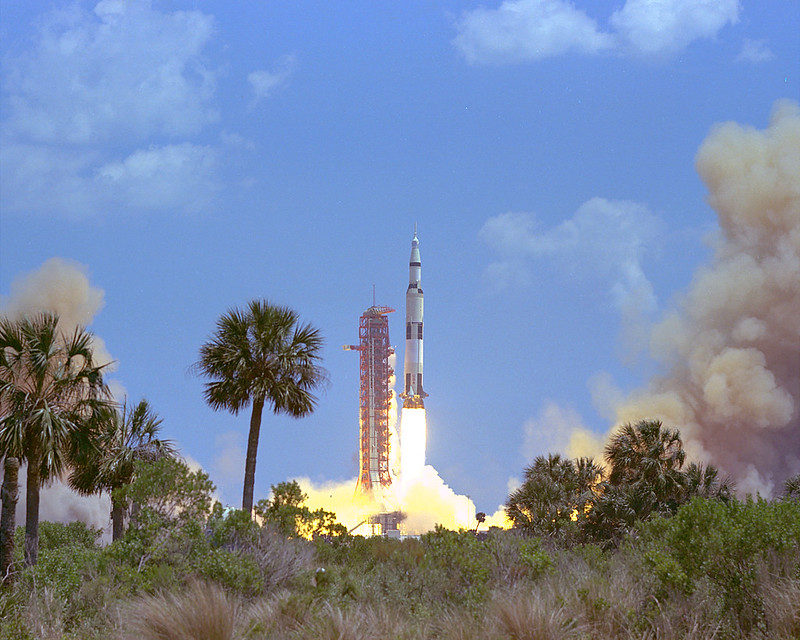
Saturn V Apollo Launch, Photo Courtesy NASA
One second following cutoff of the four outer F-1 engines, the first stage separated. Simultaneously, eight retro-rockets were fired for less than one second to slow the forward speed of the first stage, thus keeping it from bumping into the second stage. These first stage retro-rockets were located in pairs at the base of each of the outer four F-1 engines. They provided a total thrust of 88,500 pounds. Following separation, the spent first stage fell back into the Atlantic Ocean about 400 miles downrange. One second after first stage separation, eight solid-fueled motors mounted on the first/second stage adapter ring were fired for four seconds. These provided a combined thrust of 181,000 pounds. In addition to maintaining the positive motion of the rocket, these motors performed an ullage maneuver, forcing the second stage fuel to the bottom of its tanks in order to feed the engines. The five J-2 second stage engines were fired during this ullage burn.
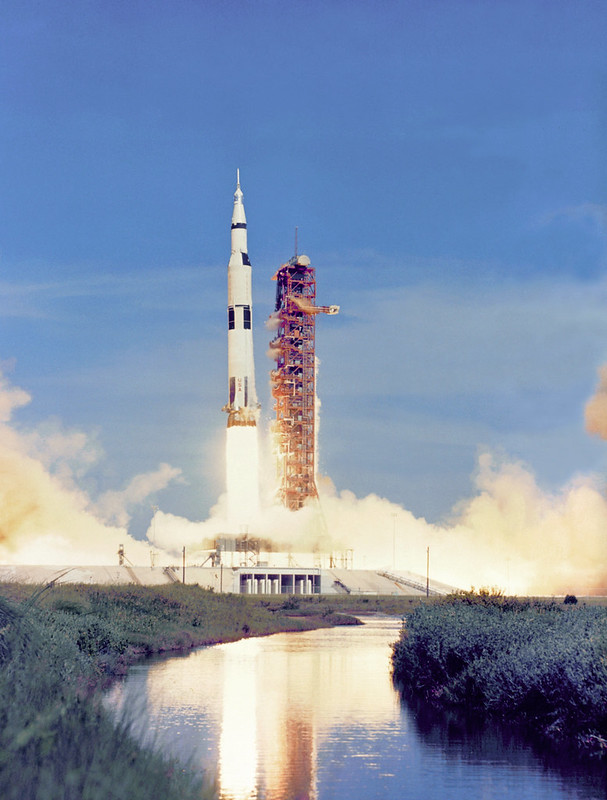
Saturn V Apollo Launch, Photo Courtesy NASA
Thirty seconds following second stage ignition, the first/second stage adapter ring separated and slid past the second stage engines for a tumble back toward Earth. Six seconds following this, the Apollo spacecraft escape tower was jettisoned. The second stage engines burned for 365 seconds prior to separation from the third stage. At separation, four solid-fueled second stage retro-rockets were fired to keep the second and third stages from hitting one another. These four retro-rockets were located in a conical adapter on the front face of the second stage. They provided a total thrust of 140,000 pounds. The second stage began its tumble, eventually impacting the Atlantic Ocean about 2,500 miles downrange. At this point, the Saturn V had achieved a speed of 15,700 m.p.h. and an altitude of 115 miles.
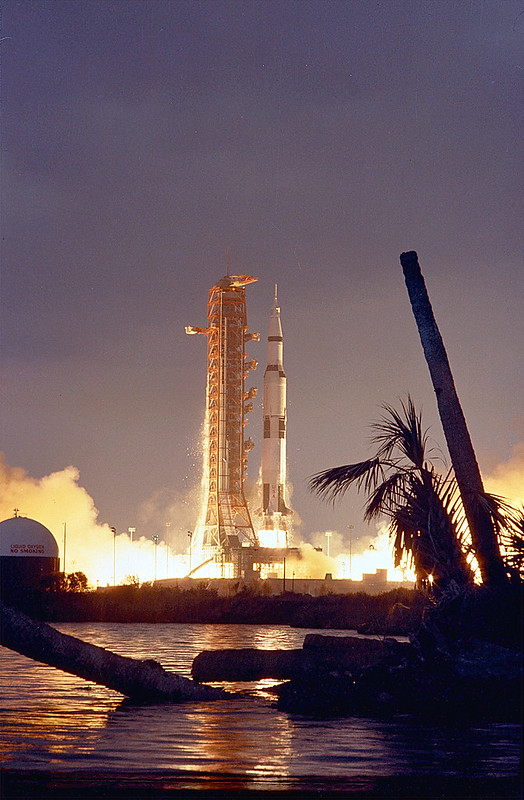
Saturn V Apollo Launch, Photo Courtesy NASA
Two solid-fueled ullage motors located 180 degrees apart on the third stage aft skirt were fired for four seconds to settle the liquid fuel. These motors produced 6,800 pounds of thrust. Three seconds after second stage separation, the S-IVB third stage J-2 engine was ignited. Nine seconds later, the third stage ullage motors which fired at separation and their cases were jettisoned. The third stage J-2 engine was fired for 142 seconds before being shut down. This initial S-IVB burn was sufficient to carry the Apollo spacecraft into a 118-mile orbit at a speed of 17,500 m.p.h. At the end of this first S-IVB burn, two ullage motors were fired to settle the remaining fuel and provide spacecraft stabilization. These ullage motors were housed in two Auxiliary Propulsion System (APS) modules located 80 degrees apart on the third stage aft skirt. Each APS module housed three attitude control motors and one ullage motor. The attitude control motors could each produce 150 pounds of thrust, while the ullage motors could each produce 70 pounds of thrust. All burned nitrogen tetroxide/hydrazine liquid fuel.
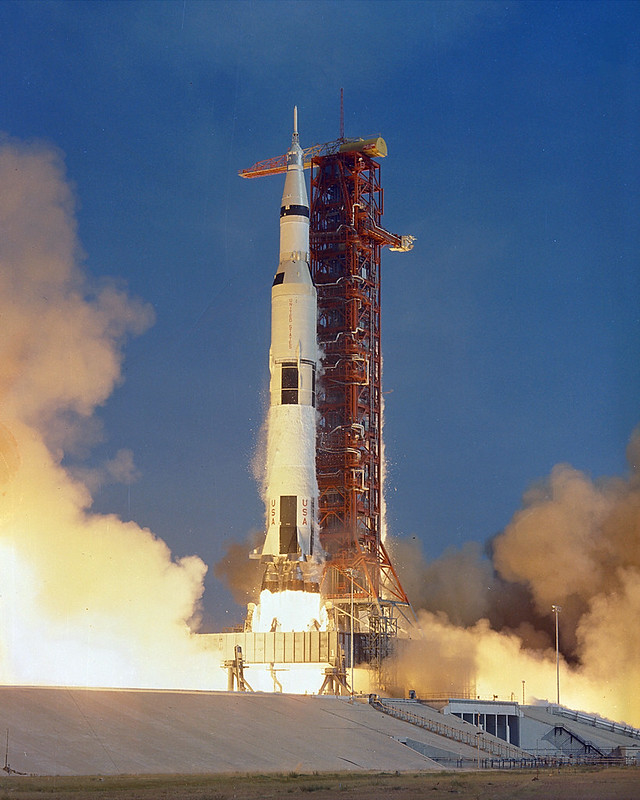
Saturn V Apollo Launch, Photo Courtesy NASA
During two or three checkout orbits, the S-IVB attitude control motors could be fired in sequence to make any necessary on-orbit corrections. Following these checkout orbits, the ullage motors were fired for 77 seconds to settle the fuel and provide forward spacecraft momentum. The third stage J-2 engine was then re-ignited for 345 seconds to achieve a speed of 25,000 m.p.h.. This second J-2 firing was necessary to carry the Apollo spacecraft out of Earth orbit and place it on a proper trajectory toward the Moon. Once the Apollo spacecraft was on its way to the Moon, the Saturn V had completed its job. The S-IVB third stage separated from the Apollo CSM/LM combination. The third stage ullage motors were fired for 280 seconds to move the S-IVB away from the CSM/LM. The third stage J-2 engine was then fired for the last time until its remaining fuel was spent. Depending upon the specific Apollo mission profile, the S-IVB was either sent toward deep space or the Moon.
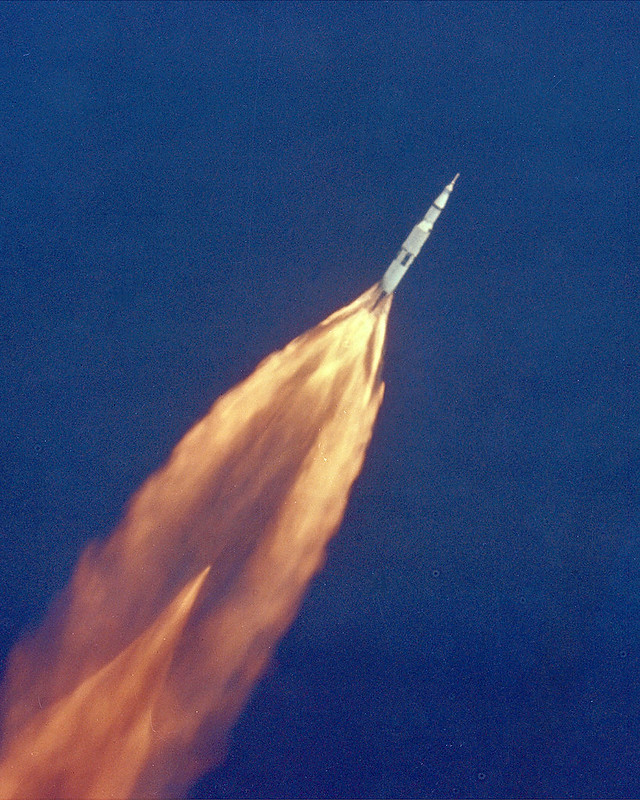
Saturn V Apollo In Flight, Photo Courtesy NASA
In several instances, spent S-IVB stages actually hit the Moon, with the resulting impact being measured by seismometers placed on the lunar surface by the Apollo astronauts. Although a two-stage version of the Saturn V was used to carry the Skylab space station into orbit, the huge rocket was effectively retired at the conclusion of the Apollo program. During its development, the Saturn V was considered as a workhorse booster of a planned Apollo Applications space science program which would follow the lunar landing missions. The Apollo Applications program never materialized as NASA chose instead to develop the Space Shuttle. In December, 1976, NASA released components of two remaining vehicles along with test articles which eventually facilitated the completion of three Saturn V displays.
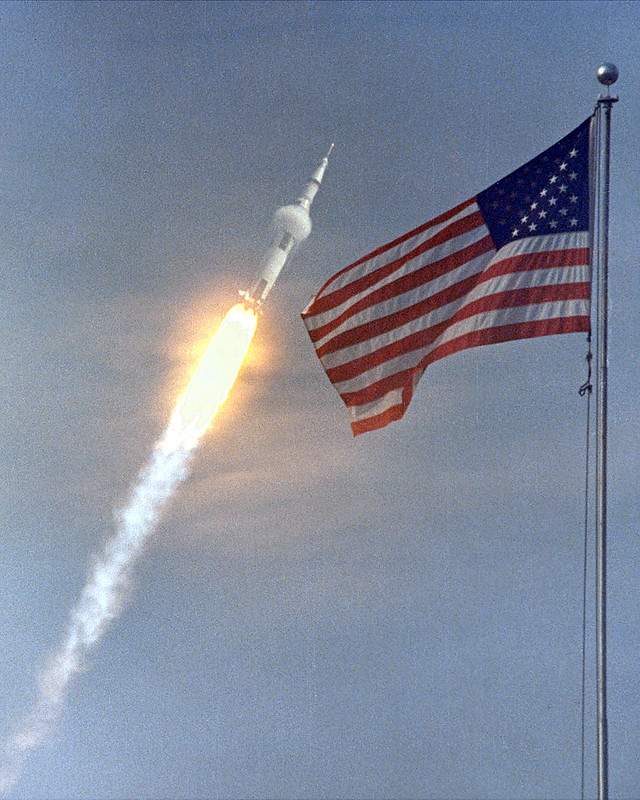
Saturn V Apollo In Flight, Photo Courtesy NASA


